Create the Timeline tab tiles bound to custom section
Starting from version 7.12.0 you can use the Timeline tab for quick analysis of customer cooperation, opportunity, case, etc. history in Creatio. This tab is available by default in the Contacts, Accounts, Leads, Opportunities and Cases sections.
Tile setup
You can set up a tile using the [TimelinePageSetting] table settings as shown in the example with the base tile. In such a case you will use the following for your tile:
- the default icon;
- the
BaseTimelineItemViewandBaseTimelineItemViewModelbase view and view model modules; - author field;
- tile caption field;
- message field.
You can use one and the same tile for different sections if needed. However, we recommend to use the [TimelineTileSetting] table and set up your tiles for different sections.
The [TimelineTileSetting] table contains tile configurations that already exist in Creatio. The section, however, will only display the tiles indicated in the [TimelinePageSetting] table for this particular section.
For example, the [TimelinePageSetting] contains three pre-configured tiles: Tasks, Leads and Calls. The [TimelinePageSetting] table contains the Tasks and Calls tiles that are pre-configured for usage in the Accounts section, and only the Calls tile that is pre-configured for usage in the Contacts section. The Leads tile in this case will not be displayed in any section.
It is considered a good practice to differentiate the tile settings. We recommend to use the [TimelineTileSetting]> table for setting up tiles, and the TimelinePageSetting – for adding the tiles to section timeline.
If you need to add the existing Files tile to a section, the "entitySchemaName” property of the [TimelinePageSetting] table should contain the entity schema name for files in the corresponding section configuration (for example, AccountFile, ContactFile, etc.). The object schema name (the "entitySchemaName” property) of the [TimelineTileSetting] table should always look as follows: "##ReferenceSchemaName##File".
The algorithm for creating a pre-configured tile
- Add a new section (if needed).
- Add a module schema to your custom package and determine the tile view class, bound to the new section. The class should be the inheritor of
BaseTimelineItemView. - Add a module schema to your custom package and determine the tile view model class, bound to the new section. The class should be the inheritor of
BaseTimelineItemView. - Add a record with the tile view settings bound to the new section into the
[TimelineTileSetting]database table. - In the
[TimelinePageSetting]table add or edit the record enabling the tile display on the Timeline tab in the necessary section.
Display the tiles bound to the Books custom section on the Timeline tab of the Accounts section. The tiles should contain:
- icon;
- name;
- author;
- book record date;
- price;
- ISBN number.
A short book description should also be displayed when you deploy the tile.
You should also edit the database tables to implement the case (see steps 4 and 5).
Example implementation algorithm
1. Adding a new Books section
Use the archive containing the needed function package to add the new Books section. Install the package via the marketplace application installation function from the *.zip archive.
You can also add the section via section wizard.
The Books section will be available in the General workplace after you install the package.

You will also see a detail displaying the linked records from the Books section on the Books tab of the Accounts section record edit page.

2. Adding a tile view module
Client module containing dependencies from the Timeline package to the custom package.
For the created module schema specify:
- Name – "UsrBookTimelineItemView";
- Title – "UsrBook Timeline Item View.”
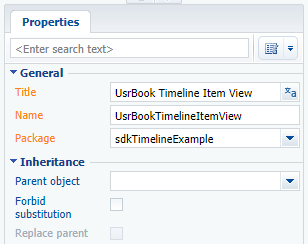
Add the following module source code to the Source Code tab of the schema:
// Defining the module and its dependencies.
define("UsrBookTimelineItemView", ["UsrBookTimelineItemViewResources", "BaseTimelineItemView"], function() {
// Defining the tile view class.
Ext.define("Terrasoft.configuration.UsrBookTimelineItemView", {
extend: "Terrasoft.BaseTimelineItemView",
alternateClassName: "Terrasoft.UsrBookTimelineItemView",
// Method returning the [UsrISBN] additional tile field configuration.
getUsrISBNViewConfig: function() {
return {
// Field name.
"name": "UsrISBN",
// Field type – label.
"itemType": Terrasoft.ViewItemType.LABEL,
// Caption.
"caption": {
"bindTo": "UsrISBN"
},
// Visibility.
"visible": {
// Binding to the tile linked entity column.
"bindTo": "UsrISBN",
// Visibility setup.
"bindConfig": {
// A field is visible if its value is populated.
"converter": "checkIsNotEmpty"
}
},
// CSS field styles.
"classes": {
"labelClass": ["timeline-text-light"]
}
};
},
// Method returning the [UsrPrice] additional tile field configuration.
getUsrPriceViewConfig: function() {
return {
"name": "UsrPrice",
"itemType": Terrasoft.ViewItemType.LABEL,
"caption": {
"bindTo": "UsrPrice"
},
"visible": {
"bindTo": "UsrPrice",
"bindConfig": {
"converter": "checkIsNotEmpty"
}
},
"classes": {
"labelClass": ["timeline-item-subject-label"]
}
};
},
// Redefined method returning the [Message] tile field configuration.
getMessageViewConfig: function() {
// Receiving standard settings.
var config = this.callParent(arguments);
// Visibility setup. Visible if the tile is deployed.
config.visible = {
"bindTo": "IsExpanded"
};
return config;
},
// Redefined method returning general tile configuration.
getBodyViewConfig: function() {
// Receiving standard settings.
var bodyConfig = this.callParent(arguments);
// Adding additional field configurations.
bodyConfig.items.unshift(this.getUsrISBNViewConfig());
bodyConfig.items.unshift(this.getUsrPriceViewConfig());
return bodyConfig;
}
});
});
Here you can define the configuration of the UsrISBN and UsrPrice fields that are additionally displayed on the tab. The standard configuration is defined in the BaseTimelineItemView module.
3. Adding a tile view model module
Add a client module schema containing dependencies from the Timeline package to the custom package.
For the created module schema specify:
- Name – "UsrBookTimelineItemViewModel";
- Title – "UsrBook timeline item view model.”
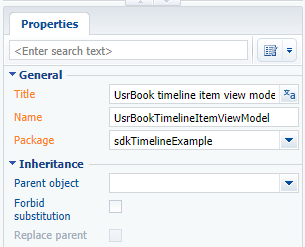
Add the following module source code to the Source Code tab of the schema:
define("UsrBookTimelineItemViewModel", ["UsrBookTimelineItemViewModelResources", "BaseTimelineItemViewModel"], function() {
Ext.define("Terrasoft.configuration.UsrBookTimelineItemViewModel", {
alternateClassName: "Terrasoft.UsrBookTimelineItemViewModel",
extend: "Terrasoft.BaseTimelineItemViewModel"
});
});
You define the Terrasoft.configuration.UsrBookTimelineItemViewModel class here. Since this class is defined as the inheritor of Terrasoft.BaseTimelineItemViewModel, it enables using all functions of the base class.
4. Adding the record with tile view settings to the [TimelineTileSetting] table
The [TimelineTileSetting] table is used to set up the timeline tile properties.
Add a new record to the [TimelineTileSetting] table. You can add a new record via the following SQL query:
INSERT INTO TimelineTileSetting (CreatedOn, CreatedById, ModifiedOn, ModifiedById, Name, Data, Image)
VALUES (GETUTCDATE(), NULL, GETUTCDATE(), NULL, 'UsrBooks', NULL, NULL);
Since data in the Data and Image columns are stored in the varbinary(max) format, use specific editors (such as dbForge Studio Express for SQL Server) to modify them. To do this:
- Select a table.
- Select the necessary record column and click the edit button.
- Enter the text data display mode in the data editor.
- Add necessary data.
- Save the changes in the data editor.
- Click the data update button.
- Click OK in the popped up checkout window to apply the modifications.
This method is only good for the development environments deployed on-site. Since the modifications are implemented directly in the database, they are not bound to any package. That is why the modifications will not be implemented in the database if the package with the view models and the tile view models is installed into another application. For correct transfer of the developed functions you need to bind the SQL-scripts that implement the corresponding modifications in the database when installing the package.
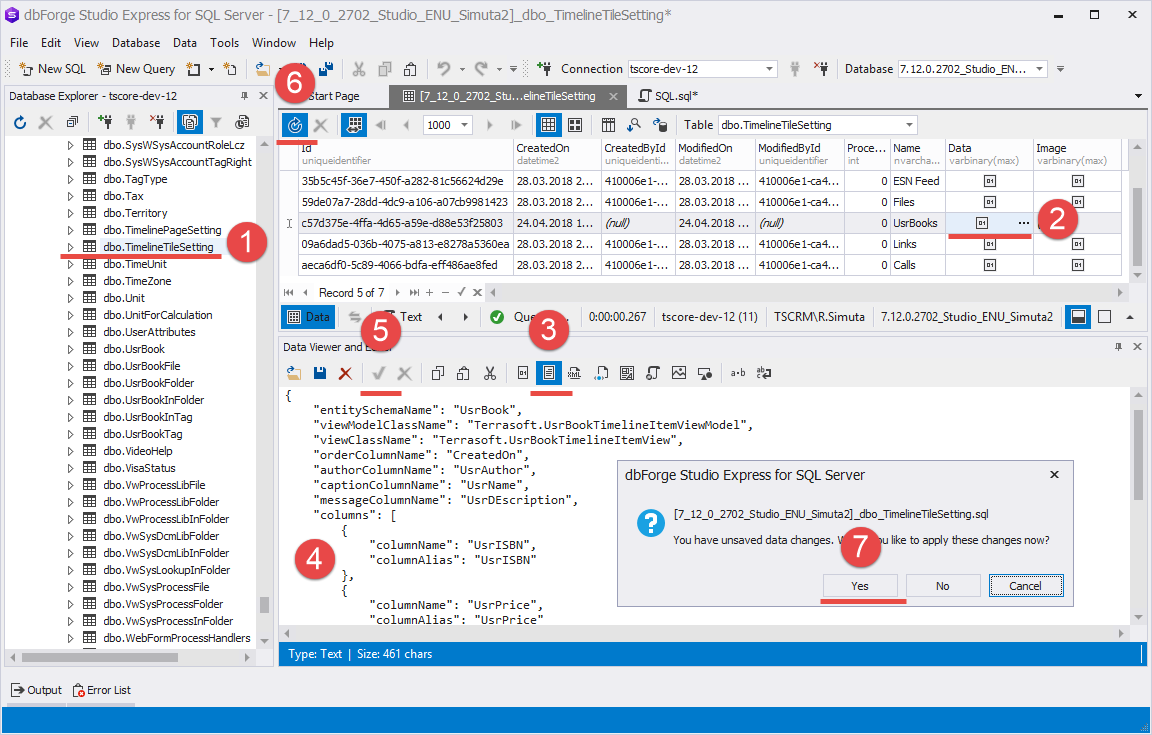
Add the following configuration object to the Data column using the above mentioned algorithm:
{
"entitySchemaName": "UsrBook",
"viewModelClassName": "Terrasoft.UsrBookTimelineItemViewModel",
"viewClassName": "Terrasoft.UsrBookTimelineItemView",
"orderColumnName": "CreatedOn",
"authorColumnName": "UsrAuthor",
"captionColumnName": "UsrName",
"messageColumnName": "UsrDEscription",
"columns": [
{
"columnName": "UsrISBN",
"columnAlias": "UsrISBN"
},
{
"columnName": "UsrPrice",
"columnAlias": "UsrPrice"
}
]
}
You need to indicate the additional field array whose display is configured in the UsrBookTimelineItemView view model in addition to the primary fields inherited from the base tile (see step 2).
Add SVG-format data to the Image column to display the icon that corresponds to the section icon.
<svg xmlns="http://www.w3.org/2000/svg" viewBox="0 0 52 52" enable-background="new 0 0 52 52">
<path d="M46.072,31.384c-0.011-0.026-0.025-0.048-0.039-0.073c-0.036-0.064-0.077-0.125-0.123-0.182
c-0.018-0.022-0.034-0.044-0.053-0.064c-0.034-0.036-0.068-0.07-0.105-0.104c-0.062-0.055-0.431-0.3-0.819-0.559
c-1.958-1.307-7.465-4.978-9.424-6.284c-0.388-0.258-0.703-0.845-0.703-1.312V3.938c0-0.401-0.19-0.777-0.512-1.017
c-0.322-0.239-0.739-0.311-1.122-0.193L15.015,8.254c-0.446,0.136-1.154,0.097-1.583-0.086l-1.094-0.467
c-0.428-0.184-0.414-0.442,0.031-0.578l15.213-4.646c0.668-0.204,1.045-0.911,0.841-1.58s-0.912-1.047-1.58-0.841L7.507,5.961
C7.454,5.982,7.429,5.994,7.403,6.005C7.338,6.031,7.276,6.062,7.217,6.097C7.205,6.104,7.191,6.108,7.178,6.116
c-0.015,0.01-0.026,0.025-0.041,0.035C7.081,6.191,7.03,6.236,6.982,6.284c-0.02,0.021-0.041,0.039-0.06,0.062
C6.864,6.412,6.813,6.485,6.77,6.562C6.716,6.659,6.683,6.748,6.658,6.838C6.651,6.864,6.648,6.89,6.642,6.916
C6.628,6.985,6.619,7.054,6.616,7.125C6.615,7.142,6.61,7.156,6.61,7.173V29.85c0,0.466-0.036,0.86-0.081,0.88l-0.081,0.036
c-0.109,0.058-0.18,0.101-0.246,0.15c-0.025,0.018-0.046,0.037-0.069,0.058c-0.056,0.049-0.107,0.103-0.154,0.161
c-0.015,0.019-0.032,0.035-0.046,0.056c-0.057,0.079-0.105,0.164-0.142,0.257c-0.006,0.015-0.008,0.03-0.014,0.045
c-0.029,0.077-0.049,0.158-0.062,0.241c-0.002,0.015-0.009,0.027-0.01,0.042c-0.002,0.018,0.002,0.036,0.001,0.054
c-0.003,0.031-0.009,0.062-0.009,0.094v7.312c0,0.393,0.182,0.762,0.493,1.002l14.766,11.391c0.226,0.175,0.499,0.264,0.773,0.264
c0.212,0,0.424-0.053,0.616-0.16l23.203-12.938c0.401-0.224,0.649-0.646,0.649-1.105v-5.766c0-0.09-0.01-0.177-0.027-0.261
C46.145,31.555,46.113,31.468,46.072,31.384z M15.4,11.625c0-0.466,0.361-0.953,0.807-1.089l15.261-4.645
c0.446-0.136,0.807,0.132,0.807,0.598v14.63c0,0.467-0.314,0.635-0.702,0.376l-1.127-0.752c-0.361-0.24-0.819-0.278-1.216-0.104
l-13.059,5.805c-0.426,0.189-0.771-0.034-0.771-0.501C15.4,25.943,15.4,11.625,15.4,11.625z M28.851,23.579
c0.425-0.189,1.085-0.134,1.473,0.125l11.43,7.62c0.388,0.259,0.368,0.644-0.045,0.86l-18.404,9.662
c-0.412,0.216-1.047,0.163-1.418-0.121l-11.789-9.001c-0.371-0.283-0.326-0.665,0.1-0.854L28.851,23.579z M9.142,9.932
c0-0.466,0.348-0.695,0.776-0.512l2.174,0.929c0.429,0.183,0.776,0.708,0.776,1.175v2.158c-1.57-0.068-2.894-0.916-3.727-1.61
L9.142,9.932L9.142,9.932z M9.142,13.152c0.931,0.671,2.22,1.323,3.727,1.372v7.633c-1.57-0.066-2.894-0.915-3.727-1.609
C9.142,20.548,9.142,13.152,9.142,13.152z M9.142,21.627c0.931,0.671,2.22,1.323,3.727,1.372v3.992c0,0.466-0.35,0.985-0.782,1.16
l-2.163,0.876c-0.432,0.175-0.782-0.061-0.782-0.527V21.627z M43.666,36.101c0,0.467-0.33,1.027-0.737,1.255L22.578,48.702
c-0.407,0.228-1.036,0.18-1.405-0.104L8.897,39.127c-0.369-0.284-0.668-0.893-0.668-1.358v-2.444c0-0.466,0.3-0.614,0.671-0.332
l12.764,9.748c0.225,0.171,0.496,0.26,0.768,0.26c0.201,0,0.403-0.048,0.588-0.146l19.899-10.447
c0.413-0.217,0.747-0.015,0.747,0.452V36.101z" style="fill:#6c91de;"/>
<path d="M33.81,34.064c0.072,0.049,0.155,0.073,0.239,0.073c0.072,0,0.145-0.018,0.209-0.055l4.505-2.575
c0.126-0.072,0.207-0.204,0.212-0.349c0.006-0.146-0.063-0.283-0.183-0.365l-9.011-6.192c-0.118-0.08-0.268-0.097-0.399-0.042
l-5.157,2.123c-0.143,0.059-0.243,0.191-0.259,0.346c-0.017,0.154,0.053,0.304,0.181,0.392L33.81,34.064z M29.492,25.426
l8.269,5.682l-3.692,2.11l-8.803-6.052L29.492,25.426z" style="fill:#6c91de;"/>
</svg>
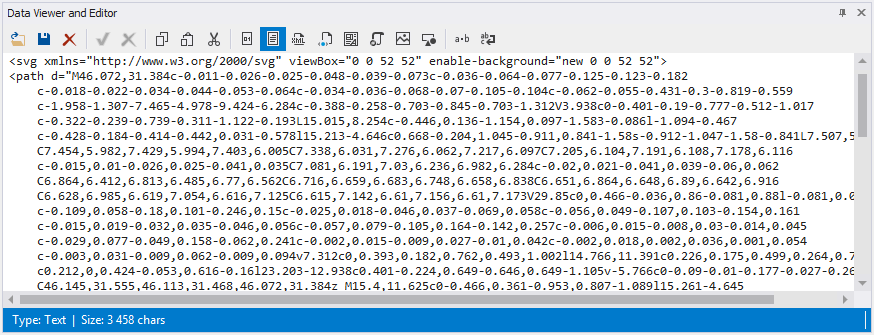
5. Editing the record that enables the tile display on the Timeline tab of the account page in the [TimelinePageSetting] table
For the Accounts section there already exists a record in the [TimelinePageSetting] table with settings of tiles bound to other sections. This is the record containing the "AccountPageV2” value in the Key column.
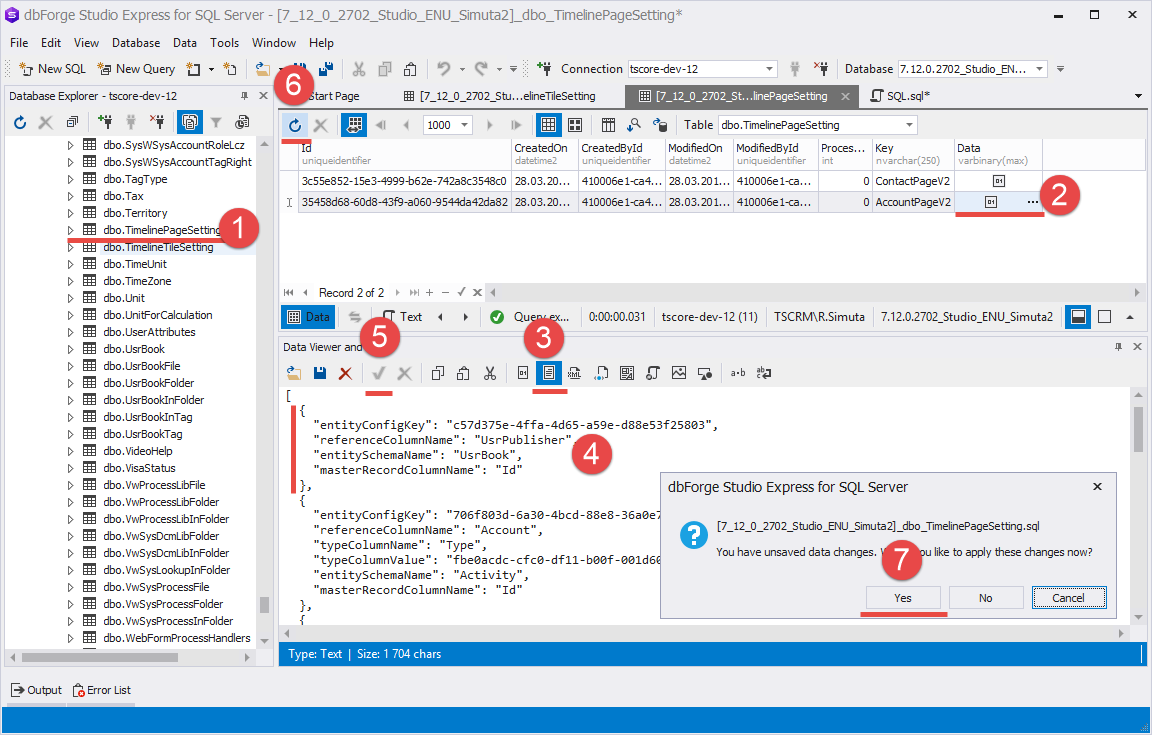
Since there are several tiles used on the Accounts section page timeline, the array of configuration objects enabling the corresponding tile is stored in the Data column.
Using the algorithm mentioned in step 4, change the configuration object array by adding a new record to it.
[
{
"entityConfigKey": "xxxxxxxx-xxxx-xxxx-xxxx-xxxxxxxxxxxx",
"referenceColumnName": "UsrPublisher",
"entitySchemaName": "UsrBook",
"masterRecordColumnName": "Id"
},
...
]
Here the "entityConfigKey” property: "xxxxxxxx-xxxx-xxxx-xxxx-xxxxxxxxxxxx” should contain the [TimelineTileSetting] table record identifier created on step 4. In our case it is the "c57d375e-4ffa-4d65-a59e-d88e53f25803” value.
The "entityConfigKey” should be obligatory indicated. It should match the Id column value of the record containing settings of the necessary tile in the [TimelineTileSetting] table.
Since the identifiers of the added records are generated at random, the generated identifier in your database will be different from the one we have in our case, when you repeat step 4.
Be careful when modifying the Data column value. Incorrect modifications can disrupt the operation of all existing timeline tiles in a section.
As a result of case implementation you will have the tiles bound to the Books custom section displayed on the Timeline tab of the Accounts section page. These tiles contain all the fields we described in our case conditions. The short book description will only be displayed when you deploy the tile.
